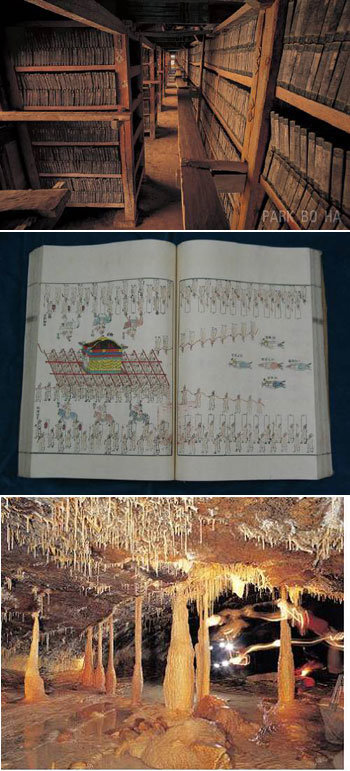World Heritage

What are the main issues related to Korean cultural assets in 2007? Experts say, Whether or not the volcanic island and lava caves in Jeju Island will be included as world heritage sites at the 31st World Heritage Committee to be held in New Zealand in June is the question. If it is registered, it will be the first in 7 years to make it on the list, and it will be the only natural heritage site of Koreas.
On Jeju Island, there are many nominees up for world heritage recognition, like the nature reservations, caves, and tuff cones in Mt. Halla. Because of the fantastic geographical features created by breathtaking scenery and volcanic activity, the preservation value of its environment is high. Last October, the International Union for Conservation of Nature and National Resources (IUCN), the consultative body of the World Heritage Committee, visited Jeju and finished its research. Shim Mi-hwa of the Korean UNESCO committee says, We cannot say for 100 percent certain that it will be chosen, but last year the committee rated the place very highly and theres a good possibility.
World heritage properties were first designated in 1972 under the The Convention Concerning the Protection of the World Cultural and Natural Heritage that determines sites worthy of world preservation. There were 830 cases in 138 countries as of July 2006. The standard must be of Outstanding Universal Value, and its value must be universal around the world, with cultural value. The general term is world heritage, but immovable cultural properties or natural scenery-related heritages are world cultural heritage, movable cultural assets are world documentary heritage, and the last category is intangible heritage.
In the six years since the Korean alphabet Hunminjeongeum, Joseon Wangjosillok (Annals of Joseon Dynasty, 1997), Seungjeongwon Journal, Jikjishimcheyojeol (2001) were listed, the Palman Daejanggyeong (Tripitaka Koreana) and Joseonwangjo Euigwe (Records of Joseon Dynasty) were chosen as candidates and will be pending until July. For world intangible heritage, Jongmyo Jerye (Royal Ancestral Rite), pansori and the Gangneung Dano Festival were chosen.
In 10 years, the world heritage provisional inventory is also changing. To apply, each country must make a provisional inventory and register in advance. 2007 is the year the decade-long cycle turns its wheel and the new provisional inventory must be submitted. The Cultural Properties Administration has made a world heritage committee and, since last year, has been examining cultural properties for the new inventory. Nine places, including Andong Hahoe Village, Samnyeonsanseong, the Muryeong Royal Tombs, the south coast fossil site, and the Joseon Royal Tombs have been registered on the examination list.
The runners-up for the list are Munmyo (Confucian shrine) in Myeongryun-dong, Jongno-gu, Buddhist temples (Hwaeom-sa, Yeongok-sa, Cheoneun-sa, Taean-sa) in Mt. Jiri , the Gangjin site of 183 kilns that baked pottery from the Goryeo dynasty, the Buddhist temples in mountains located in southern part of Korea (Songgwang-sa and Seonam-sa in Mt. Jogye, Daeheung-sa in Mt. Daedun, Baekyang-sa in Mt. Baekan, Muwi-sa and Dogap-sa in Mt. Wolchul, and Unju-sa in Hwasun), sea route and historical heritage district in Jindo, Dosan Seowon (Confucian academy), and Suncheon Eupseong. The damaged Bangudae rock carvings were examined last year for qualifications. Large areas such as foreshore of the West Sea and Koreas traditional salt farms are included as well.
If they are chosen, there are many social, cultural, and economic advantages that follow. Internationally, a positive image of the country and local society will be reinforced and the conservation funds will increase, along with investment for the related surrounding areas and facilities. Kakadu National Park in Australia, Yellowstone National Park in the United States, and Halong Bay in Vietnam all experienced a tourism boom after being registered as world cultural heritage. UNESCO also provides grants and human resources.
Experts say, When foreign visitors are touring the provinces, they tend to go to the world heritage sites first. If maintenance is poor, then it may be crossed off the list, so the local organizations and residents also get more involved in protecting the sites.
zozo@donga.com







